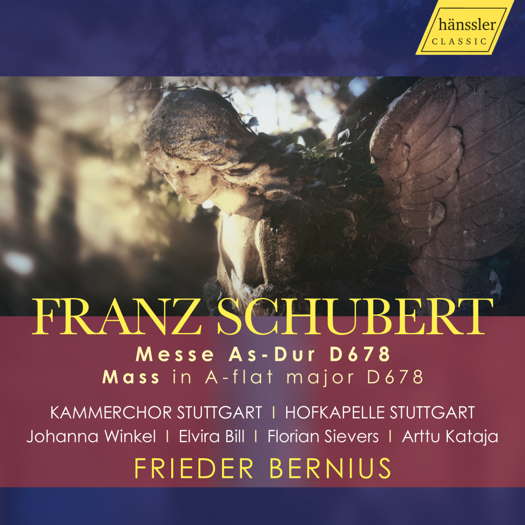 SPONSORED: CD Spotlight. Perfect Indeed - More Beethoven from James Brawn, recommended by Andrew Schartmann.
SPONSORED: CD Spotlight. Perfect Indeed - More Beethoven from James Brawn, recommended by Andrew Schartmann.
All sponsored features >>

Songful and Inventive
Franz Schubert's Mass in A flat, recorded in Stuttgart and enthusiastically recommended by GERALD FENECH
'... evocative, passionate and often gloriously mystical ...'
The musical reputation of Franz Schubert (1797-1828) rests mainly on his some six hundred 'lieder' and chamber works. But he was also a fine symphonist and had an innate gift for the sacred, despite being almost totally unreligious. Indeed, from 1814 until the year of his demise, he composed six Latin Masses, the most famous being the last two in A flat and E flat, the latter written in the last months of 1828.
But here we are concerned with the fifth in A flat, D 768. Schubert commenced composition on this mass in November 1819, completing it three years later in 1822. Various projects had competed for the composer's attention in the meantime, including his brother Ferdinand's request for a mass (D 755). Schubert wrote out the organ part in October or November 1822 and, although plans were made for a performance in 1823, records of a performance in Schubert's lifetime do not exist.
This setting and the E flat of 1828 are regarded as Schubert's 'late masses'. These are distinguished from his four early masses written between 1814-1816 by their musically interpretive stance to the words, when Schubert began to take advantage of an overall maturation in his technical abilities and knowledge of harmony. The composer revised his original setting in 1825, producing a shorter, simplified fugue for the 'Cum Sancto Spiritu' section of the 'Gloria' and changing the 'Hosanna'.
Listen — Schubert: Gloria (Mass in A flat, D 768)
(HC22041 track 2, 9:34-10:17) ℗ 2023 Hänssler Classic :
Listen — Schubert: Benedictus (Mass in A flat, D 768)
(HC22041 track 5, 3:46-4:31) ℗ 2023 Hänssler Classic :
Keen to acquire the post of deputy 'Kapellmeister' in the Imperial Court Chapel, Schubert used this revised version as an audition, but this venture proved unsuccessful.
The Schubert scholar Brian Newbould considered these two Masses to be the finest and most substantial settings, and the composer regarded the A flat piece as one of his very best creations, judging by his extended efforts and numerous returns to the score. Indeed, he even considered dedicating it to the Emperor, and even thought of it as his 'Missa Solemnis'.
This Mass can be rightly considered as his most songful and inventive in the genre, and the integration of soloists and chorus, mastery of fluid harmonies and idiomatic treatment of the orchestra's woodwind section, give the Mass in A flat a symphonic quality which would later inspire Bruckner.
Frieder Bernius and his Stuttgart team of superb singers - choir included - and players have stiff competition, but the performance is nothing short of enthralling.
Listen — Schubert: Kyrie (Mass in A flat, D 768)
(HC22041 track 5, 0:01-0:58) ℗ 2023 Hänssler Classic :
Bernius' conducting is consistently involving and his meticulous attention to detail allows him to strike a perfect balance between the animated and meditative elements of the score. This is an evocative, passionate and often gloriously mystical rendition of one of Schubert's great choral pieces.
Listen — Schubert: Agnus Dei (Mass in A flat, D 768)
(HC22041 track 6, 4:59-5:57) ℗ 2023 Hänssler Classic :
Sound and presentation are first-rate. Enthusiastically recommended.
Copyright © 3 March 2023
Gerald Fenech,
Gzira, Malta




